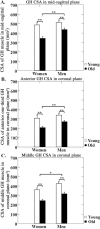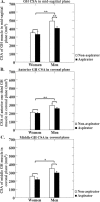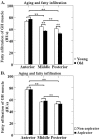Aging-related geniohyoid muscle atrophy is related to aspiration status in healthy older adults
- PMID: 23112114
- PMCID: PMC3732109
- DOI: 10.1093/gerona/gls225
Aging-related geniohyoid muscle atrophy is related to aspiration status in healthy older adults
Abstract
Background: Age-related muscle weakness due to atrophy and fatty infiltration in orofacial muscles may be related to swallowing deficits in older adults. An important component of safe swallowing is the geniohyoid (GH) muscle, which helps elevate and stabilize the hyoid bone, thus protecting the airway. This study aimed to explore whether aging and aspiration in older adults were related to GH muscle atrophy and fatty infiltration.
Method: Eighty computed tomography scans of the head and neck from 40 healthy older (average age 78 years) and 40 younger adults (average age 32 years) were analyzed. Twenty aspirators and 20 nonaspirators from the 40 older adults had been identified previously. Two-dimensional views in the sagittal and coronal planes were used to measure the GH cross-sectional area and fatty infiltration.
Results: GH cross-sectional area was larger in men than in women (p < .05). Decreased cross-sectional area was associated with aging (p < .05), and cross-sectional area was significantly smaller in aspirators compared with nonaspirators, but only among the older men (p < .01). Increasing fatty infiltration was associated with aging in the middle (p < .05) and posterior (p < .01) portions of the GH muscle. There was no significant difference in fatty infiltration of the GH muscle among aspirators and nonaspirators.
Conclusion: GH muscle atrophy was associated with aging and aspiration. Fatty infiltration in the GH muscle was increased with aging but not related to aspiration status. These findings suggest that GH muscle atrophy may be a component of decreased swallowing safety and aspiration in older adults and warrants further investigation.
Keywords: Aspiration; Atrophy; CT scans.; Fatty infiltration; Geniohyoid muscle; Older adults; Swallow.
Figures




Similar articles
-
Age-related changes of hyoid bone position in healthy older adults with aspiration.Laryngoscope. 2014 Jun;124(6):E231-6. doi: 10.1002/lary.24453. Epub 2013 Nov 13. Laryngoscope. 2014. PMID: 24227680
-
Age-related composition changes in swallowing-related muscles: a Dixon MRI study.Aging Clin Exp Res. 2021 Dec;33(12):3205-3213. doi: 10.1007/s40520-021-01859-2. Epub 2021 Apr 26. Aging Clin Exp Res. 2021. PMID: 33904143
-
The relationship of aspiration status with tongue and handgrip strength in healthy older adults.J Gerontol A Biol Sci Med Sci. 2011 Apr;66(4):452-8. doi: 10.1093/gerona/glq234. Epub 2011 Feb 7. J Gerontol A Biol Sci Med Sci. 2011. PMID: 21300744 Free PMC article.
-
Computed tomography pulmonary findings in healthy older adult aspirators versus nonaspirators.Laryngoscope. 2014 Feb;124(2):494-7. doi: 10.1002/lary.24284. Epub 2013 Aug 5. Laryngoscope. 2014. PMID: 23832617 Free PMC article.
-
Association between sarcopenia and pneumonia in older people.Geriatr Gerontol Int. 2020 Jan;20(1):7-13. doi: 10.1111/ggi.13839. Epub 2019 Dec 6. Geriatr Gerontol Int. 2020. PMID: 31808265 Review.
Cited by
-
Supracricoid laryngectomy: the impact of senescence on swallowing safety.Einstein (Sao Paulo). 2021 May 10;19:eAO5715. doi: 10.31744/einstein_journal/2021AO5715. eCollection 2021. Einstein (Sao Paulo). 2021. PMID: 33978098 Free PMC article.
-
Relationship between daily swallowing frequency and pneumonia in patients with severe cerebral palsy.BMC Pediatr. 2022 Aug 13;22(1):485. doi: 10.1186/s12887-022-03547-0. BMC Pediatr. 2022. PMID: 35964106 Free PMC article.
-
Association of aging and tooth loss with masseter muscle characteristics: an ultrasonographic study.Clin Oral Investig. 2020 Nov;24(11):3881-3888. doi: 10.1007/s00784-020-03255-y. Epub 2020 Mar 16. Clin Oral Investig. 2020. PMID: 32180027
-
Impact of geniohyoid and masseter muscle masses on dysphagia after salvage surgery and radiotherapy in head and neck cancer.Sci Rep. 2021 Jan 26;11(1):2278. doi: 10.1038/s41598-021-82039-0. Sci Rep. 2021. PMID: 33500539 Free PMC article.
-
Possible Rehabilitation Procedures to Treat Sarcopenic Dysphagia.Nutrients. 2022 Feb 12;14(4):778. doi: 10.3390/nu14040778. Nutrients. 2022. PMID: 35215427 Free PMC article. Review.
References
-
- Rofes L, Arreola V, Romea M, et al. Pathophysiology of oropharyngeal dysphagia in the frail elderly. Neurogastroenterol Motil. 2010;22:851–858, e230 - PubMed
-
- Vergis EN, Brennen C, Wagener M, Muder RR. Pneumonia in long-term care: a prospective case-control study of risk factors and impact on survival. Arch Intern Med. 2001;161:2378–2381 - PubMed
-
- Angus DC, Linde-Zwirble WT, Lidicker J, Clermont G, Carcillo J, Pinsky MR. Epidemiology of severe sepsis in the United States: analysis of incidence, outcome, and associated costs of care. Crit Care Med. 2001;29:1303–1310 - PubMed
-
- Cabre M, Serra-Prat M, Palomera E, Almirall J, Pallares R, Clavé P. Prevalence and prognostic implications of dysphagia in elderly patients with pneumonia. Age Ageing. 2010;39:39–45 - PubMed
-
- Huxley EJ, Viroslav J, Gray WR, Pierce AK. Pharyngeal aspiration in normal adults and patients with depressed consciousness. Am J Med. 1978;64:564–568 - PubMed
Publication types
MeSH terms
Grants and funding
LinkOut - more resources
Full Text Sources
Medical

